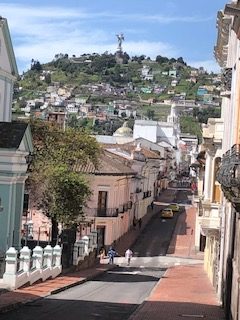
By Robert Waite
Quito, Ecuador – There are three things to keep in mind when planning a visit to Quito, capital of Ecuador.
First, it is high. Not Cusco-high, but — at 9,350 feet (2,850 meters )– you’re 2,000 feet (610 meters) higher than Mexico City. It may take you a few days to acclimate.
Second, it is hilly. As one who once lived on Russian Hill in San Francisco, I thought I knew hilly, but Quito even beats the City by the Bay.
Third, it is old. The present-day city was established by Spaniards in 1534, almost 100 years before the founding of Boston. And indigenous peoples lived here for centuries before that.
And if I were to add a fourth, it would be not to miss the surrounding countryside, known for its mountains, lush natural beauty, and a chance to straddle the Equator itself.
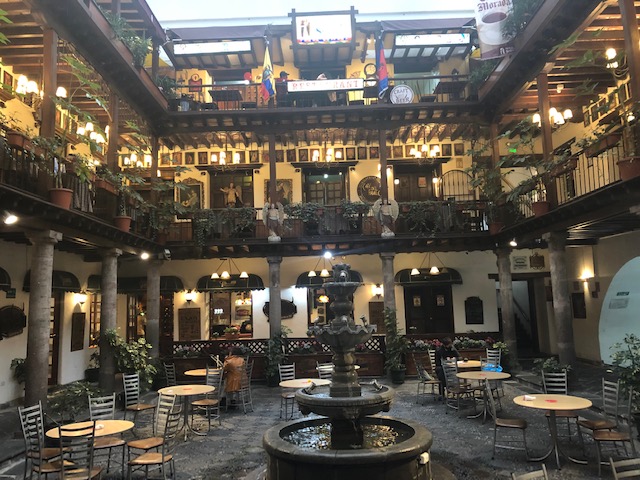
Altitude, Antiquity, and an Archbishop’s Digs
The altitude attests to the fact that you are amidst Andean peaks, including snow-capped volcanoes. The hills reflect that the city is laid out in a long, narrow valley, necessitating streets that run up its slopes, much like a ship’s transverse framing ribs bend upwards from its keel.
And Quito’s relative antiquity, most evident in and around its Old Town plazas and squares, evokes a colonial-era atmosphere nearly five centuries after its birth. You can almost hear the clacking of hooves on the cobblestones.
We made our base of operations the Hotel Patio Andaluz, a restored 16th-century mansion just off the Plaza Grande.
The Plaza Grande is indeed grand, featuring a winged statue dedicated to independence atop a pillar at its center and flanked by the Palacio Presidencial, the Catedral Metropolita de Quito, and the Palacio Arzobispal.
The size and scale of the latter says it must have been very good to have been Archbishop in Colonial Quito (much of it today is given over to commercial activities).

Exploring the Old City
After spending time at Plaza Grande in the company of our guide, Pablo, we next headed on foot to Plaza San Francisco, about three blocks away. Here you will find the San Francisco Church, the oldest edifice in the city.
This church and its associated structures were begun in 1534 on the site of an Inca royal residence. It grew to be the largest urban religious complex in South America (only the Jesuit mission complexes in what is now northern Argentina rivaled it in scale).
The church itself, built in stages, features many decorative motifs that clearly were influenced by indigenous traditions and beliefs –- melding Christian symbols with those familiar to recent converts.
In some ways the most interesting space is actually found beneath San Francisco, in a rabbit warren-like shopping arcade entered from the plaza. All manner of local handicrafts, including masks, shawls, and ponchos, are available for sale. Not for the claustrophobic –- but well worth a look.
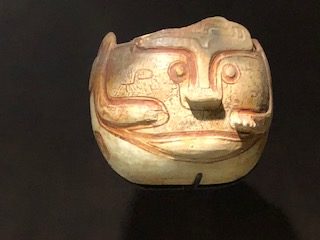
Pre-Columbian Art
Not far from Plaza San Francisco was our favorite of the city’s many museums –- La Casa de Alabado.
Located in a restored 17th-century home, the museum houses a wonderful collection of pre-Columbian art, well displayed and with good signage. It differs from some museums in that it is not arranged chronologically, but rather thematically. For example, one section focuses on the “Spiritual World of the Shaman,” another on “The Social World: Power and the Elite.”
If you want a bird’s-eye view of Quito, head to La Basilica del Voto Nacional. While relatively new (construction began in 1892) and still officially unfinished, this neo-Gothic church is worth a visit for its stained glass windows and panorama of the city below.
Another interesting vantage point, a park named El Panecillo, features a towering 98-foot (30 meter) statue of the Virgin Mary. Designed and originally assembled in Spain, it is fashioned from 7,400 aluminum panels that were numbered, shipped to Quito, and reassembled.
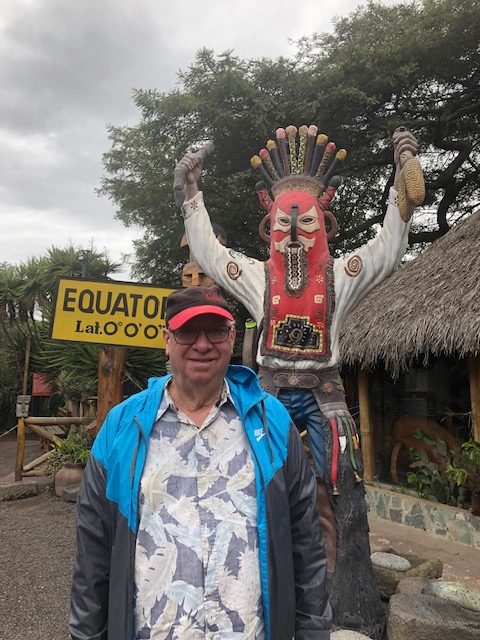
The Equator — Or Is It?
After a few days (and many good meals) in Quito, we next headed for the Middle of the World.
The Middle of the World is not to be confused with Tolkien’s Middle Earth – although both are fictional.
Ecuador’s Middle of the World is an elaborate complex said to mark the Equator. A monument stands on the spot that an 18th-century French-Spanish geodetic expedition determined was precisely zero degrees latitude. The Ecuadorian government in 1936 removed families from the site to create today’s park-like setting.
Which was great – until the invention of GPS and modern laser-measuring devices proved that the 18th-century scientists had miscalculated by about 1,000 feet (300 meters). Demonstrating that there is occasionally justice in this world, the real site of the Equator fell on the very land of the families who had been forced to move.
Today, you can visit the “official” government site, or you can go to the privately run Museo de Sitio Intinan.
Both are worth a look, but the private attraction is more fun. You can have your picture taken with one foot in each hemisphere; flush water in opposite directions on either side of the line; and try to balance an egg on the Equator (something few accomplish, although my spouse did, winning a nifty certificate in the process).
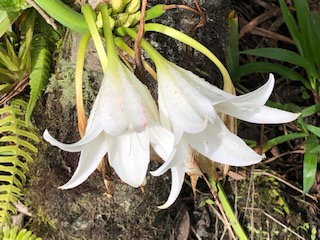
Volcanoes and Cloud Forests
There is much more to see in the countryside outside Quito. The National Park of Cotopaxi contains the highest active volcano in the world, which rises nearly 20,000 feet (6,100 meters) in snow-capped splendor. You can attempt a steep climb to the snowline marking the edge of its glacier — or, for the less ambitious, hike around a picturesque lake near its base.
And while Ecuador’s claim to be the most biodiverse country on the planet is usually attributed to its Amazon rain forest and Galapagos Islands regions, the area around Quito in central Ecuador also plays a major role.
About two hours from the city lies the Mindo Cloud Forest, located in the Mindo-Nambillo Protected Forest. Here you will experience a veritable cornucopia of ecosystems in the lush surroundings, allowing opportunities to encounter exotic birds, butterflies, and plant species.
Not far away is the private Pahuma Orchid Reserve, where you can take a leisurely (and not overly difficult) hike through a botanical wonderland festooned with all manner of orchids.
I had always identified orchids with places like Malaysia, Thailand, or the Brazilian Amazon, but I had never seen so many in one place, outside of a flower show. Hummingbirds, rainbow-hued quetzals, tanagers, and toucans also populate the reserve.
We had intended to visit the Cotopaxi outdoor market, one of the largest and most active in the region, but it was closed on Tuesday, so our guide wondered if we would be interested in visiting a company devoted to the cultivation of roses instead. A thorny question – but, we said, why not?

Floral Fantasia
It turns out that Ecuador has displaced Colombia in recent years as the largest exporter of cut roses in the world. For anyone interested in horticulture and international commerce, a visit to the Royal Flowers green house and distribution center is a must.
This one production center boasts mind-numbing factoids: 240 acres under greenhouses; over 1,100 workers (dubbed “flower caretakers”); over 90 million stems exported yearly to all corners of the globe.
You can take a tour with a guide, who will explain that Mother’s Day, Valentine’s Day, and International Women’s Day are the peak demand holidays. She will also tell you that Ecuador’s roses are best because they have the straightest stems.
Why? “Because we are on the Equator and the sun is always straight above us at noon.”
Whatever the reason, the place moves more than 20,000 roses every day, rushing them to refrigerated FedEx, UPS, and DHS cargo aircraft headed for places like Miami, Los Angeles, New York, Toronto — as well as Shanghai and Beijing.
That evening we headed back to Quito for a farewell dinner at Café Plaza Grande, a high-end dining establishment just around the corner from our hotel. It will come as no surprise that it had an arrangement of Ecuadorean roses, standing straight and tall.
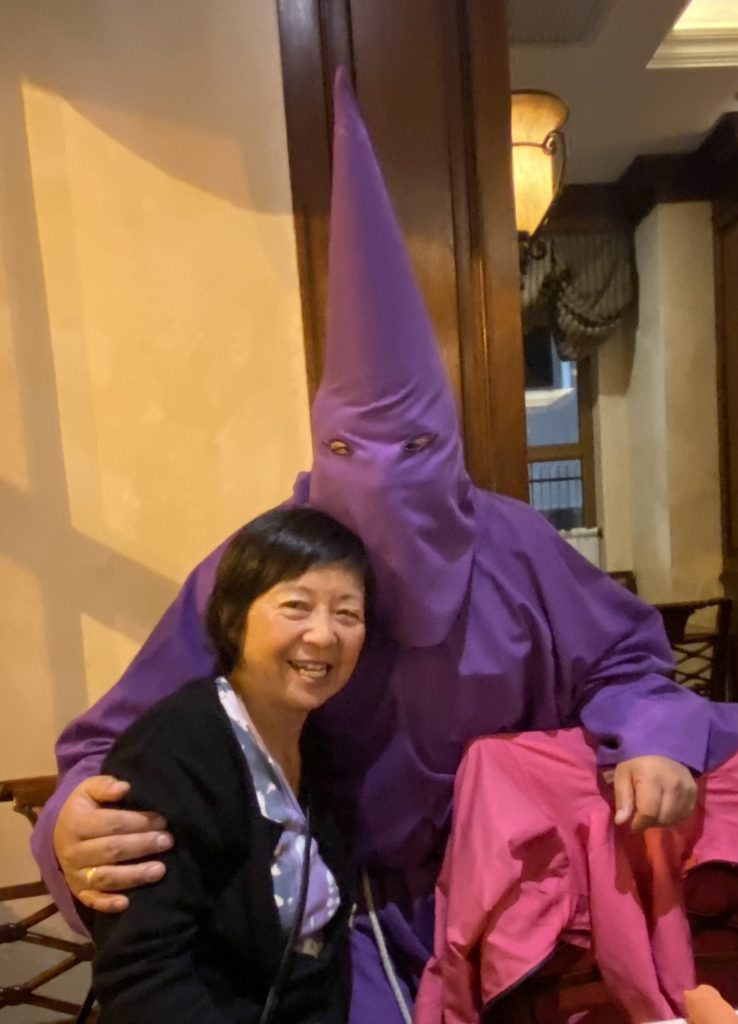
Surprise!
But what did surprise us was the arrival of a “Cucurucho” in our dining area. This individual was dressed in a purple robe with a purple peaked hood, looking disturbingly like a Klan member whose robes might have fallen into a vat of grape juice.
It turned out that we visitors were being shown the outfit that those seeking penance wear during Easter Week. The hood, the fellow told us (once he had his hood off), represented humility. Hundreds of similarly attired penitents would converge on the Cathedral over Easter.
As it was November, we were being given a preview of coming attractions. And it’s yet another reason to put Quito on your list.
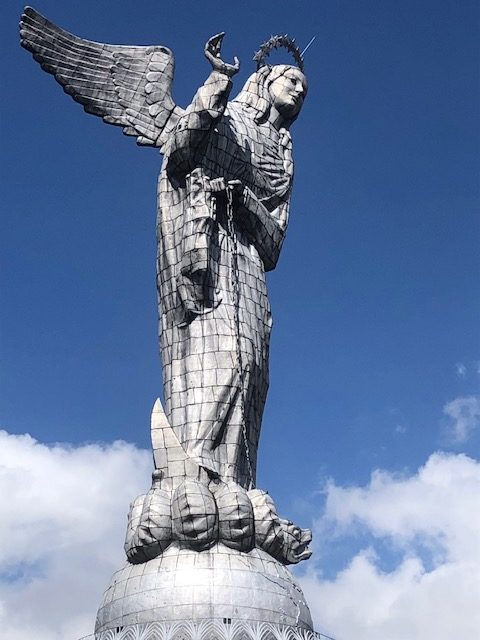
If You Go
Ecuador uses the U.S. dollar as its currency. Even the cash machines spew out greenbacks.
Quito is served by American Airlines, JetBlue, United, and Copa Airlines (from numerous North American Cities via Panama City). Air Canada is expected to resume Quito service from Toronto later this year.
The Old Town section of Quito appeared to be relatively safe –- Tourist Police visibly hang about –- but as with any large metro area you should exercise caution, especially at night.
Our land arrangements were made through Enchanting Travels, Greenwood Village, Colorado.
We stayed at Hotel Patio Andaluz, which was excellent. The nearby Hotel Plaza Grande would also be a good choice.
Author Bio:
Contributing writer Robert Waite wrote most recently about visiting Panama On and Beyond the Canal. Watch this site for his upcoming posts on Ecuador’s Amazon headwaters and Galapagos Islands.
Top photo of Quito’s hilly streets by Robert Waite
You may also want to check out:
Reader Comments:
Thanks for sending this article! Our traveling days have been severely curtailed…and it was a welcome diversion from a dreary, rainy Saturday. Please send more. — Ann H. Causey












One Response to Quito: High, Hilly, Old — and Delightful